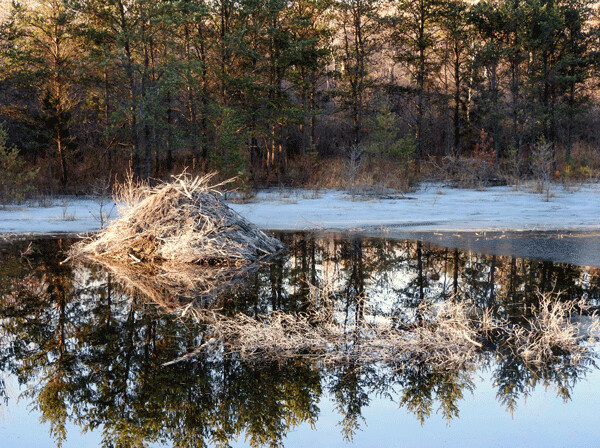News & Articles
Browse all content by date.

Driving eastward at dawn can be a breathtaking experience. On a recent frosty morning, I feasted my eyes on the world. Every bare stick, brittle weed, and blade of grass was either encrusted in diamonds or set on fire. Of course, in the moments where I transitioned from brilliant light into deep shade, I held my breath against the possibility that a deer would jump through the juncture. The combination of beauty and danger was exhilarating and exhausting.
So when I came upon a beaver lodge with every stick frosted and glowing, I decided that it was time to take a photo break. A clump of half-submerged sticks out in front of the lodge indicated that it had been occupied last fall, as the beavers were preparing their food store for winter. Beavers stay somewhat active all year and can access this food cache from under the ice.
To maintain that liquid highway is one of the main reasons that beavers build dams. The pond behind the dam not only lets them swim closer to the trees, it also provides them with aquatic vegetation to eat all summer, and creates an underwater world inaccessible to predators in winter.
As I scanned the beavers’ pond for more photo ops, a ghost emerged from the shadows. Soon I could focus on the swan’s elegant neck, pure white breast feathers, and its rippling reflection. Charitably, the bird gave a low, nasally call, identifying itself as a trumpeter swan. They are hard to distinguish from tundra swans without the help of sound.
Trumpeter swans are frequent residents of Wisconsin beaver ponds when they migrate back for the summer. The habitat is perfect. Like beavers, they eat a wide variety of aquatic plants, such as pondweed, wild rice, and algae; and they prefer shallow wetlands less than six feet deep. The tops of old beaver lodges also provide excellent nest sites for swans, who seek existing mounds surrounded by water and less than 600 feet from shore.
Even though frumpy, brown beavers and elegant, white swans could hardly look more different, they are similar in more ways than just their habitat needs. Beavers and swans also share a common and history on hats.
Beavers were plentiful across the Great Lakes region until the European demand for beaver felt hats lead to extensive fur trapping. As it turns out, the structure of a beaver’s soft underfur allows it to make extremely strong and malleable felt when processed with heat and pressure. Felt hats were fashionable in Europe from 1550 to 1850, but the European, Scandinavian, and Russian beaver populations were trapped out by 1600. Explorers turned to the new continent for a steady supply of pelts.
When logging and slash fires also entered the scene, beaver populations collapsed. Their numbers likely reached an all-time low in 1900. Beaver trapping seasons in Wisconsin were closed, and they began to come back in northern Wisconsin with the help of restocking efforts initiated in 1932. By the late 1970s, beavers had recovered enough to allow extensive trapping again. In fact, beavers have rebounded so well that they are now considered a nuisance by many, and long trapping seasons have begun to reduce their populations.

The hat industry was tough on animals. Swan feathers adorned fashionable hats, and were also used for ladies’ powder puffs, and writing quills. Fashion trends spurred extensive swan hunting from the 1600s until the late 1800s. By that time, the swans were almost gone in Wisconsin and across the country. The demise of beavers—and their habitat construction services—may have contributed to the swans’ downward trend. A small population survived in remote mountain valleys out west.
Once they were protected, trumpeter swans slowly increased, and by the late 1960s, forty birds were reintroduced to Minnesota. In 1989, Wisconsin received its own batch of swans. Trumpeter swans recovered so spectacularly that Wisconsin removed them from the state endangered species list in 2009. And the population continues to grow. The 2015 population survey counted 4,695 individuals, up from 672 in 2010.
That population increase is visible even to the unaided eye. I’m seeing swans everywhere this spring. They are flying over icy lakes; drifting down the newly-open water of the river; feeding in the sloughs; and emerging from the shadows near a beaver lodge. Emerging, it seems, from the shadows of near extinction into a sparkling morning of recovery.
The beaver’s recovery, while similar in many ways and just as dramatic, is less attractive to certain land managers. Still, beavers are incredible land managers themselves, and an uncountable number of other species depend on them for habitat. If we admire swans, then perhaps we should remember to appreciate the beavers as well.
Special Note: Emily’s book, Natural Connections: Exploring Northwoods Nature through Science and Your Senses is here! Order your copy at http://cablemuseum.org/natural-connections-book/. Listen to the podcast at www.cablemusum.org!
For 50 years, the Cable Natural History Museum has served to connect you to the Northwoods. Come visit us in Cable, WI! Our new exhibit: “Better Together--Celebrating a Natural Community” will open on May 2!
| Tweet |


